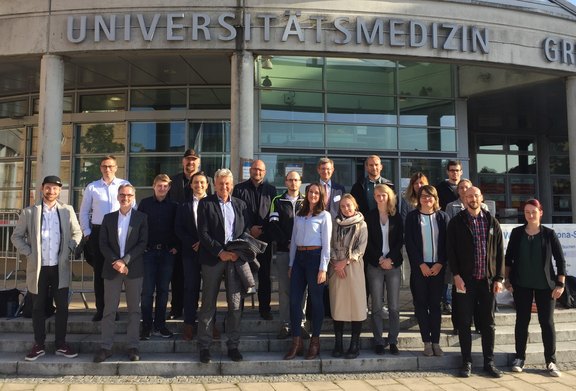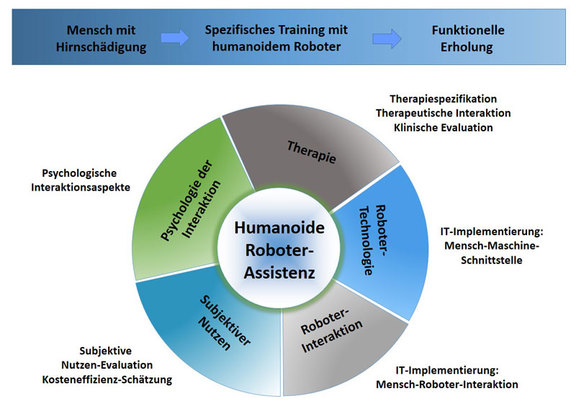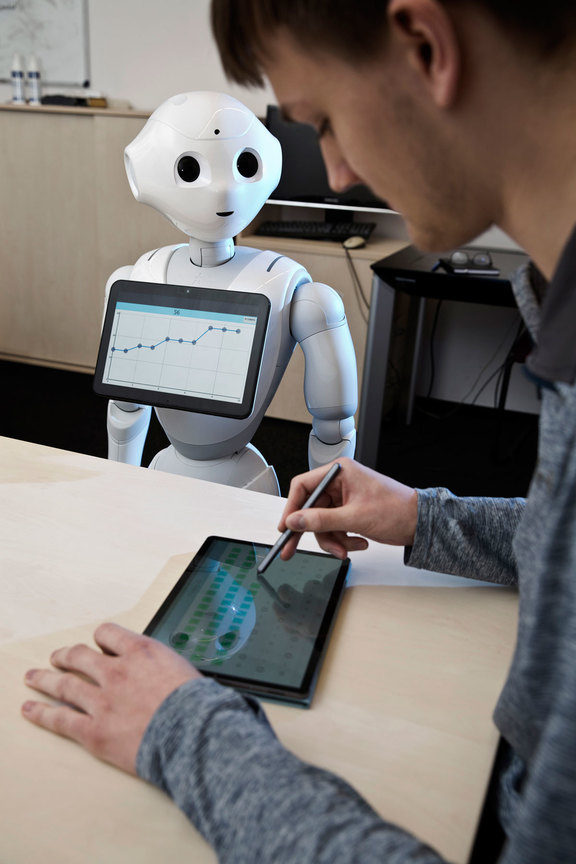E-BRAiN - the project
Evidence-based robotic assistance in neurorehabilitation
Stroke-related disabilities ("neuro-disabilities") are increasing significantly worldwide, a trend that will continue in the years to come. At the same time, evidence-based neurorehabilitative treatment that is adequate both in terms of contents and “dosage” (intensity) can sustainably reduce disability and restore independence in everyday life. But how can this be achieved if the demand grows, but the resources presumably not to the extent needed?
Humanoid robots as therapy-assistants in neurorehabilitation have the potential to expand the scope of action of human practitioners (physicians and therapists). If such a strategy could successfully be implemented, the disabilities could be reduced or even avoided.
So far, this is, however, only an idea. Such humanoid robots for therapy do not yet exist. For their development, a number of scientific questions need to be addressed, which require a genuine inter-professional approach. Without such an approach a serious and socially responsible development couldn’t be achieved. The multi-professional research network E-BRAiN will answer some of the related question.
Firstly, the possibility to implement neurorehabilitative treatment (motor skills, visual system, cognition) digitally using a robot needs to be explored collaboratively by physicians and computer scientists. Since a humanoid robot has a "human-like" appearance, interacts with speech and mimically, its activity as a "therapeutic assistant" has to be designed and evaluated in terms of a "relationship" (work alliance). For this purpose psychological expertise is needed. In addition, phenomena of individualized human-human interaction accounting for stroke-related disabilities have to be studied and considered. And, even if the development of a humanoid robot as therapy assistant was feasible, questions of users acceptance and preferences, clinical effects as well as costs are all relevant for a potential use as healthcare application.
Qualification of the upcoming generation of scientists
The qualification of students and scientific staff is the core of the project and is carried out through vertical and horizontal networking.
In every working group (neurorehabiliation, computer science, psychology, health economy) student assistants (e.g. medical students) or research assistants (e.g. students in computer science, psychology, and health economy) are systematically integrated and introduced to research questions and methodology.
Master students in computer science, psychology, health economy learn how to conduct research and doctorate candidates can improve and apply their scientific skills.
The new research network of institutions creates opportunities for inter-professional research. Each discipline contributes its focus with its own methodology. At the same time, the research is genuinely collaborative.
Young scientists thus learn both inter-professional team research and about topics, methods and limitations of the other disciplines` research with direct reference to research questions in their own field.
Scientific knowledge, argumentation and presentation are learned through the establishment of joint educational initiatives (regular collaborative meetings, public lectures, and final international symposium).
Across all qualification levels and participating institutions, attendance in joint research and qualification meetings is expected from all participants.
This also makes collaborative research an "inter-professional scientific collaborative qualification."
THE STATE OF MECKLENBURG-VORPOMMERN IS SUPPORTING THE AMBITIOUS DIGITIZATION PROJECT WITH FUNDING FROM THE EUROPEAN SOCIAL FUND (ESF) WORTH ALMOST 2 MILLION EUROS.


